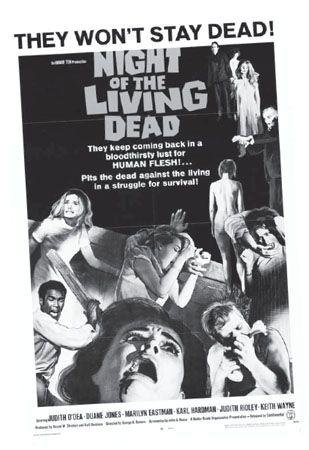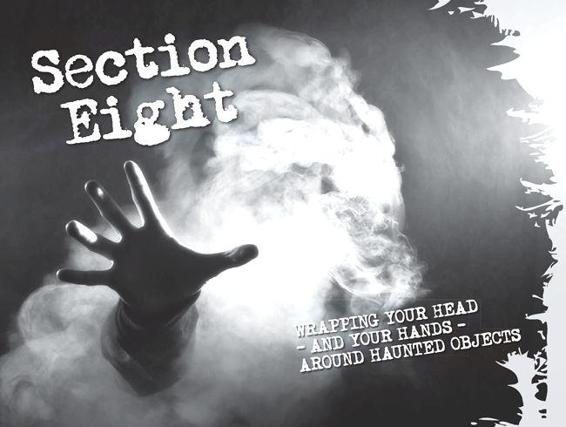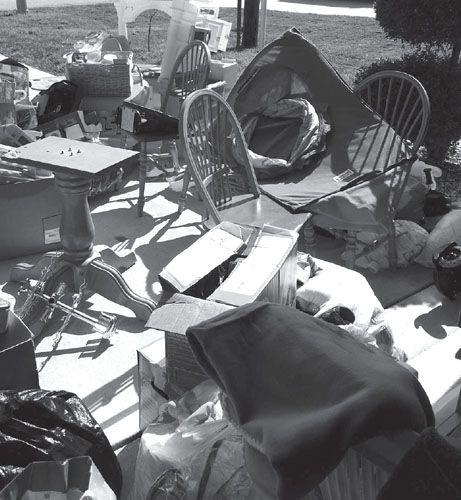Haunted Objects: Stories of Ghosts on Your Shelf (26 page)
Read Haunted Objects: Stories of Ghosts on Your Shelf Online
Authors: Christopher Balzano,Tim Weisberg


A 1968
Night of the Living Dead
poster similar to the one at the center of a paranormal stir in the D’Agostino household.
On Jan. 8, 1991, Jeremy Wade Delle stepped into his English class and committed suicide while his classmates watched. The event took place before the rise of gun violence in schools that has marked our culture since, and the students at Richardson High School in Richardson, Texas, saw their lives changed forever. There has been much written about the details of that day, especially after the band Pearl Jam made the story famous with their hit song, “Jeremy,” and its graphic video.
Though the room where the tragedy occurred was reopened as a classroom, it eventually was turned into a storage area for old desks. Several students reported that some time after the shooting, after school hours, a gunshot could be heard coming from the room, and at times desks stored there would be overturned or thrown against the wall.
The story I heard, which involved Jeremy’s best friend at the time, was told to me by a friend of that teen’s girlfriend. The news has always painted Jeremy as a sad child, and while the press and the band have stressed this, he did have a few close friends.
Jeremy and his closest friend had made a suicide pact, and while Jeremy lived up to his end of the bargain, the other teen did not. This friend was consumed by guilt and rumored to be under the influence of drugs. He kept hearing Jeremy’s voice asking him why he had not killed himself yet. He even once saw the outline of his friend against a steamy bathroom mirror.
One night it all came to a head. He laid in bed, staring at a poster he and Jeremy had hung on the ceiling. The poster featured a popular band they both liked. Before Jeremy’s suicide, the two would often gaze at it and talk about music and life.
As the boy thought about Jeremy that night, the four thumbtacks used to attach the poster to the ceiling fell on his face, even the tacks that should have naturally fallen near his feet. While he watched the poster hang in midair, his old friend’s voice continued to ask him why he was still alive. After more than a minute, the poster floated down and spread out like a blanket over him.
The teen did not kill himself as Jeremy urged. At the time I heard the story, more than 15 years ago, he had turned his life around. The girl who told me the story hasn’t talked to either the boy or his girlfriend since. I am not sure what happened to him after that, although it seems the final communication from his departed friend had the opposite effect than what was intended. The teen and his story—much like Jeremy, whose pain became a hit song—is now part of the landscape of rumor.

Getting Attached
T
he blanket that Grandma made for you when you were a baby. The doll that always sat on a chair in Aunt Mary’s bedroom. Grandpa’s favorite pipe.
When someone dies, it’s not unusual for those left behind to want a keepsake, some sort of physical object that reminds them of the deceased. It may be an item that was given to them by a loved one or that belonged to the loved one, a reminder to the living of the person who is gone. It can be as profound as wanting to move into their house or as mundane as wanting a simple tchotchke. Some of the keepsakes may seem strange to the outside observer, but they may have deep meaning to the person in mourning and help with the grieving process.
And apparently, it works from the “other side” as well.
Sometimes those who have died are not ready to give up a special object. They still want to own it, cling to it, or perhaps even use it as a conduit to stay connected with those they’ve left behind.
Paranormal researchers often talk about “attachment theory.” This is not to be confused with the work of psychoanalyst John Bowlby, who devised his attachment theory regarding the interactions between human beings. Instead, the paranormal theory is more about entity or spirit attachment—the ability to imprint energy on people, places, or things. Whether to the living or the deceased, these objects matter. They take on a significance that goes beyond just material possession. The most inconsequential trinket can become a means to connect with the Great Beyond.
Most cases of attachment to an object turn out to be nothing more than a residual haunt; that is, it’s just the leftover energy of a person that is attached, so it is unable to interact with the living. But there are plenty of instances in which it is an intelligent haunt, and therefore, communication or interaction with the spirit is possible.
The concept of spirit attachment leads to a debate among paranormal researchers when it comes to the idea of a haunted location: We look for factors in the location that can explain why it is haunted, such as a quartz rock in the foundation to retain energy or nearby running water to charge the ions in the air and amplify the energy. But isn’t it possible that the spirit has just chosen to attach itself to the spot? Isn’t a building nothing more than a large object?
Attachment isn’t limited to just objects, either; it’s just as likely for a spirit to attach itself to a person. This can happen either intentionally or by accident—many paranormal investigators have reported “bringing home” spirits who’ve become attached to them during an investigation. Some will even say a protection prayer or conduct a ceremony before investigating, in order to keep any spirits from attaching to them purposely or inadvertently.

Some people believe spirits can move between our dimension and theirs, bringing and taking objects with them.
Even if an object doesn’t attach itself to a person or an object, it can still focus on one. A reported sign of spirit activity is a phenomenon known as apportation, in which objects mysteriously appear or disappear through the influence of spirits. Ever wondered why your car keys are never where you left them, or why that one sock keeps disappearing in the dryer? The answer might not be as simple as you think. Spirits that can manipulate objects may be moving them in order to capture attention or announce their presence, putting them somewhere other than where they were last seen. One theory suggests that spirits can actually bring solid materials into their own dimension, thus causing them to outright disappear, before bringing them back into this plane.
Another side of apportation involves the spirit bringing an object through to our world that might not have been here previously. One example in this book, on P. 142, involves the St. Christopher’s medal that appeared out of nowhere to help a family through some trying times. It was not their medal and never had been, yet it showed up when they most needed it. Did the spirit bring it into creation, or was it apported from some other location? The jury is still out on that, but the stories in which the phenomenon occurs continue.
There’s one more concept of how material objects relate to paranormal activity, called a trigger object. Trigger objects are designed to get a “rise” out of a spirit, through some sort of connection the spirit has with it or a similar item. It’s an experimental way to make contact; the spirit doesn’t have to be actually attached to the object in order for it to work. For example, if a young woman who has died was fond of a certain doll, bringing that doll into a location she is suspected to haunt might entice her to make herself known.
Just as they can be susceptible to spirit attachments, people, too, can serve as trigger objects—especially when the spirit is considered to be dark or even evil in nature. When investigating an old prison and trying to make contact with the spirit of a serial rapist, a woman might be placed alone in his former cell in order to serve as the trigger object and draw him out.
Trigger objects don’t have to be physical items, either; sometimes playing music of a certain era or speaking in a particular language or dialect can serve to activate paranormal activity.
For all the research that has been done on attachment theory in recent years, it’s still unclear how or why it occurs. The best guess, however, is that most spirit attachment happens because the spirit wants it to happen. That gives a whole new meaning to the expression that one person’s trash is another person’s treasure.
Hands–on Experience
Psychic medium Pam Patalano has been touched with a gift, and touch is a big part of how she uses it.
“You’d be surprised what’s haunted and what’s not,” she said. “It’s all in how you handle it.”
“Handle” is the operative word. Pam practices psychometry, a type of extra sensory perception in which touching and holding an object can reveal its history through psychic means.
The term psychometry was coined by Joseph Rodes Buchanan in 1842. Buchanan, a physician and professor of physiology at the Eclectic Medical Institute in Covington, Kentucky, used psychometry as a means to “measure the soul.” It was embraced by the Spiritualist movement beginning in the late 1840s, and although Buchanan himself was a Spiritualist, he believed that spirits do not come into play when practicing psychometry. Instead, it centers on the psychic abilities of a person to perceive the soul; as the “psychometer,” this person is responsible for measuring and interpreting whatever energies might be attached to an object.
Nearly 170 years later, Pam agrees.
“Basically, I refer to it as ‘object recognition,’ ” she said. “Touching an object is no different than touching a person’s hand. If there’s an emotion attached to it, I can pick up on it.”
Although the object is the focus of her attention, it’s not the physical item itself that carries the spirit.
“Everything in the universe has an energy field that radiates all around it,” she said. “These emotions, these impressions, they are absorbed within that energy field. It’s not necessarily inside the object, but it exists in that energy field. I read that energy.
“I pick up an object, close my hands around it, and I start getting images. If there was an emotion attached to it—if somebody loved it, used it to kill somebody, whatever—I can see it. Sometimes I’ll hear a message without seeing anything, but more often it’s like seeing a film.”
But unlike a residual haunting, in which the same scene plays over and over again, the images often change using psychometry.
“It’s not the same thing all the time. I can pick up different ‘movie clips’ from it, so to speak,” she said. “It’s not the same picture over and over again. There’s a story attached to it.”

